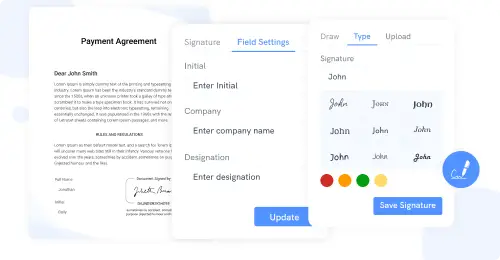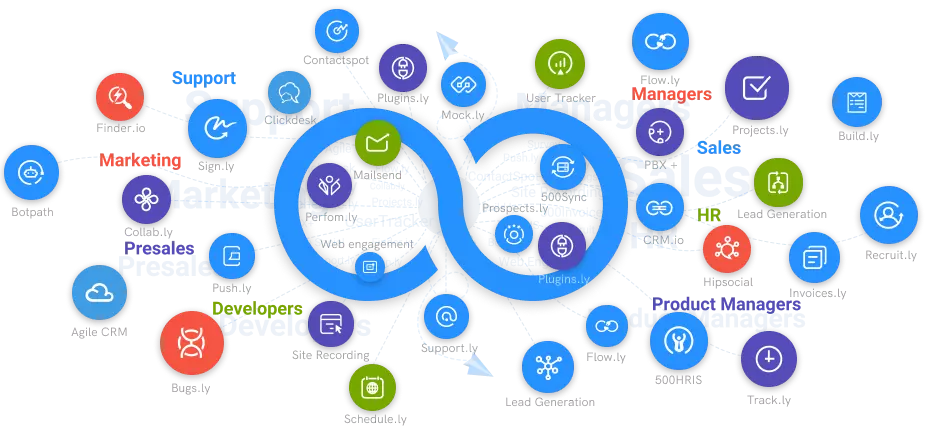Digital Signature and Cryptography in Cryptocurrency
With the birth of cryptocurrencies, a new wave of progress has taken place that connects cryptography and distributed computing. The full extent of this technology's potential can only be appreciated through a thorough examination.
#1
Get digital signatures on documents like sales contracts, employee HR letters, and more
#2
Create components like signature, date, initials on document via drag and drop builder
#3
Enable multi-party signing and share documents to multiple users
#4
Choose from 15+ scenario based pre-designed templates
#5
Upload documents from your local system or cloud providers like Dropbox, Google Drive and 500Box
#6
Track individual signee status for each document
#7
Send documents for signature from your favorite CRM software like CRM.io
#8
Set a hierarchical order for signing documents
#9
Unbelievable pricing - the lowest you will ever find
#10
Everything your business needs - 50 apps, 24/5 support and 99.95% uptime
With the birth of cryptocurrencies, a new wave of progress has taken place that connects cryptography and distributed computing. Granted, cryptocurrencies represent a polarized concept in our minds: on the one hand, they are considered highly volatile and speculative assets, and on the other, they represent a revolutionary technology that represents the potential to transform existing systems and structures. There is a general consensus that understanding this nascent technology is a daunting task filled with technical jargon and complex concepts beyond most of us. The full extent of this technology's potential can only be appreciated through a thorough examination.

What is Digital Signature?
Digital signature online are mathematical procedures that allow recipients to verify the authenticity of digital messages, documents, or transactions almost with 100% certainty. Digital signatures are created every time a new document, email, or message is signed, so each signature is unique, resistant to tampering, and virtually impossible to counterfeit. A recipient should have no reason to doubt the validity of a digital signature or the integrity of a message when a digital signature is properly implemented.
How does a digital signature work?
To Learn how digital signature creator work by taking a step-by-step look at this technology. Regardless of the type of digital signature—Bitcoin, PDF, SSL, or email—the steps are very similar.
1. Data Hashing
Hashing (sometimes called ""hashing"" function) is the process of converting any form of data into a unique string of alphanumeric text process requires the use of a hashing function, an algorithm that converts any data input into a data output (also called a “digest” or simply, a “hash”) with a fixed size. There are many hashing functions that can be used to convert data; the size of the digest depends on the hashing function used. There are two main types of hashing functions: Message Digest 5 (MD5) and Secure Hash Algorithm (SHA).
The result of a hash function on a given message or document acts as an electronic fingerprint for that message or document. The hash is then utilized as one of the digital signature's components. This will eventually allow the message or transaction's recipient to verify that nothing has been changed and that the digital signature attached to it is genuine.
2. Asymmetric Cryptography
Cryptography is a means of securing data by encrypting it using codes, guaranteeing that only the intended receiver can process and read it. The technology that underpins cryptocurrency is based on cryptography. Asymmetric and symmetric cryptography are the two forms of cryptography. Symmetric cryptography is the process of encrypting (encoding) data on the sender's side and decrypting (decoding) data on the receiver's side using a single key (code). The key is only known by the two parties — the sender and recipient — ensuring the transaction's security. However, there is a risk of the key being compromised if it is shared over the Internet.
Users are given a pair of keys, a private key, and a public key, using asymmetric cryptography, which is employed by Bitcoin and the majority of cryptocurrencies. A public key may be freely shared with anybody, but a private key is totally secret and can only be shared or revealed by the user. A public key is analogous to your bank account, whereas a private key is analogous to the pin you use to access your bank account.
Creating a digital signature
The sender must then sign the message with a digital signature once the data has been hashed. Each digital signature is specific to the message or transaction being signed, as stated in the introduction. A digital signature can never be reused or repurposed after it has been used once.
The procedure of establishing a digital signature online is painless from the perspective of the end-user. Behind the scenes, all of the technical phases in the process are completed automatically. In truth, creating a digital signature is pretty difficult.
A random integer is created and multiplied with a point known as the generator point to form the random component. Various implementations of elliptic curve cryptography (ECC) employ different curves, and characteristics like the generating point are known ahead of time. The Bitcoin protocol, for example, implements the secp2561k curve. The generator point used to create a public key from a Bitcoin private key is the same generator point used for digital signatures.
Why Do We Need A Digital Signature For Blockchain Transactions?
To develop locking and unlocking scripts that establish the requirements for spending a specific UTXO, Bitcoin leverages the Bitcoin Script programming language. Every transaction input includes an unlocking script that includes a public key (or address) as well as a digital signature. This helps the network to confirm that the UTXO spender has the right private key.
The Elliptic Curve Digital Signature Algorithm (ECDSA) is the digital signature algorithm used by the Bitcoin network. The digital signature verifies that the sender of a transaction has access to the private key associated with the BTC address. As a result, the person who makes the digital signature can also unlock cash delivered to the pubkey or address associated with it. To put it another way, a digital signature verifies that a document is authentic.
Conclusion
Blockchain technology was not the first to use distributed computing. In the field of computer science, topics like asymmetric cryptography, hashing, and digital signatures are not new. However, blockchain technology is groundbreaking because it combines these different processes — both old and new — into a single distributed ecosystem.
All communications are standardized and easily verifiable thanks to one-way hashing techniques that transform any type of data into an arbitrary "fingerprint". Any manipulation of the underlying data would be immediately detected because the digest would be completely different. When you add in a cryptographic system that uses a set of public and private keys, the resulting transaction has exponentially higher degrees of integrity and non-repudiation, two characteristics that are important to the blockchain. These two basic components form the foundation of digital signatures, which are employed by Bitcoin and, by extension, the majority of cryptocurrencies on the market. Every transaction is safe, thanks to a sophisticated and interdependent system of self-reinforcing rules that ensure that all parties involved in the process are intrinsically (economically) aligned.





